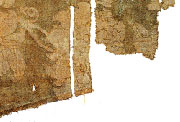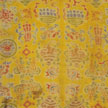 |
 |
||||||||||||||||||||||||||||||||||||||||
 |
|||||||||||||||||||||||||||||||||||||||||
 |
|||||||||||||||||||||||||||||||||||||||||
| CHAPTER 8 | |||||||||||||||||||||||||||||||||||||||||
 |
|||||||||||||||||||||||||||||||||||||||||
| 0801 The Eight Buddhist Emblems 0801 (c.17th century) |
|||||||||||||||||||||||||||||||||||||||||
| Multi-colour clamp-resist dyeing Dimension: L189cm; W66cm Chris Hall Collection Trust, Hong Kong |
|||||||||||||||||||||||||||||||||||||||||
 |
|||||||||||||||||||||||||||||||||||||||||
| THE BOOK | |||||||||||||||||||||||||||||||||||||||||
| AUTHOR | |||||||||||||||||||||||||||||||||||||||||
| CONTENTS | |||||||||||||||||||||||||||||||||||||||||
| The Eight Buddhist Emblems are: the conch, an emblem of the voice preaching the Buddhist doctrine; the wheel, symbolizing the eternal, unchanging laws of the doctrine; the umbrella, with its ability to expand and contract; the canopy, symbol of extensive coverage; the lotus, symbol of purity; the vase, its condition of "non-leaking" symbolizing completeness; the fish, for its energy and strength; and the endless knot, for its continuous quality. They came into being during the Song and Yuan dynasties (13th-14th century AD)(07.09b), and became popular in the Ming dynasty. The patterns are achieved by clamp-resist dyeing, and the piece is the cover for a tangka. The fabric is folded into layers and clamped between a pair of wood panels which are engraved with the desired pattern. When the dye is poured in, the engraved area would take in the dye. This technique is invented in the Tang dynasty, and became very popular during the Song, Liao, and Xixia periods. It was still used in the Ming dynasty, although somewhat confined in certain areas, are made specifically for covering tangkas. Similar textiles exist in large quantity, and they are decorated with a large variety of motifs including fruits and melons and Chinese characters. Examples are collected in the Palace Museum, Beijing. Note: Huang 1986 |
|||||||||||||||||||||||||||||||||||||||||
| ORDER | |||||||||||||||||||||||||||||||||||||||||
| CONTACT | |||||||||||||||||||||||||||||||||||||||||
| LINKS | |||||||||||||||||||||||||||||||||||||||||
|
|
||||||||||||||||||||||||||||||||||||||||